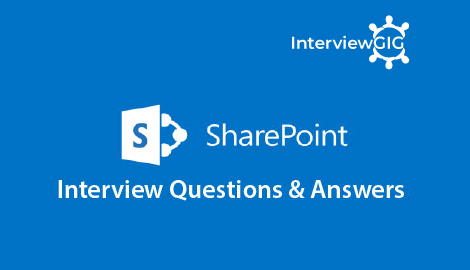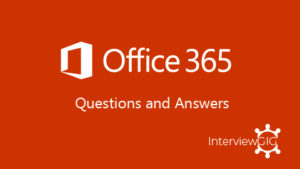What do you mean by MOSS?
- MOSS stands for Microsoft Office SharePoint Server.
- It is the complete version of a portal-based platform for collaboratively creating, managing and sharing documents and Web services.
Explain SPSite?
SPSite –
- It is a site collection and can be represented as SPSite class in the object model.
- SPSite object is a primary entry points to the server object model.
- It is used frequently in SharePoint application development.
Explain Site template?
- Site template provides the basic component and layout of a new site to be created in SharePoint.
- It contains specific design information about a site which includes
- the list that is part of the site,
- web part pages used in the site,
- the site’s themes and borders,
- changes to the quick launch bar,
- some site content like document libraries
- It allows to build the SharePoint applications to be instantiated time and again.
What are the various classes in Server Object Model from development point of view?
Following are the classes in Server Object Model from development point of view:
-
- SPFarm
- SPWebApplication
- SPSite
- SPWeb
- SPList
- SPListItem
- SPDocumentLibrary
Which class is used to retrieve data from multiple lists?
- SPSiteDataQuery class is used to retrieve data from multiple lists.
- It queries the data from multiple lists across different sites in a collection.
- Usually it is used in list aggregation, where list data from team sites or other subsites is collated and presented in a single interface.
- It aggregates the data from SharePoint lists only while ignoring data from external lists.
What do you mean by WSP?
- WSP stands for Web Solution Package. It is a cabinet file that contains assemblies, resource files, features, images, application pages, site definitions etc. into single file.
- Whenever any customization or up gradation or up dation is carried out in SharePoint, various items like assemblies, resource files, features, images, application pages, site definitions etc. are required to deployed.
- It becomes difficult to deploy these items separately in development, staging and production. This called for a powerful deployment tool in the form of WSP.
How is Allow Unsafe Updates used?
- When a developer updates the content database without requiring a security validation Allow Unsafe Updates property is set to true.
- One the operation is carried out, the property is again set to false.
Which is better - SPS or STS?
Before we begin – let us see what do these two abbreviations stand for.
- SPS means SharePoint Portal Services
- STS means SharePoint Team Services
i.) Document management system in SPS is better than STS.
ii.) The search engine in SPS is better, more efficient and possesses the capability to crawl multiple content sources in comparison to STS.
iii.) If Document Management is not required, STS is easier to manage for team environment while SPS is better for an organization where Document Management is required.
Name the various input forms that can be created for a workflow?
- Association form
- Initiation form
- Modification form
- Task edit form.
What are the various zones in SharePoint?
- Zones provide the separate logical paths of authentication for the same web application.
- 5 zones can be created for each web application:
- Default
- Intranet
- Extranet
- Internet and
- Custom
Explain Farm in SharePoint?
- Farm is a collection of SharePoint servers with same configuration database.
- All the required information to run the farm is carried in Configuration DB. There exists only one configuration database for each farm.
- Central administration is used for the administration of each farm.
Explain Web Application?
- Web Application is a IIS website. Content database is created for each Web Application
- Web Application can be created from central admin.
- Once a web application is created, it can be extended to different zones.
Differentiate between WSS 3.0 and MOSS 2007?
- WSS 3.0 is freely available with Windows Server while MOSS 2007 is a paid product.
- MOSS 2007 has some more features like Enterprise Search, Business Data Catalog(BDC), User Profile, Excel Services, Single-Sign on, additional Workflows, My site feature etc. in addition to those in WSS 3.0.
Explain BDC?
- BDC also called Business Data Catalogue is used to connect to an external database and read it in SharePoint.
Explain BCS?
- BCS also called Business connectivity Services is new in SharePoint2010. BCS aids in reading and writing into the external Database.
Explain Content types in Sharepoint?
- A content type is a WSS type definition which is flexible and reusable.
- It is used to define the columns and behaviour for an item in a list or a document in a document library.
Differentiate between Library vs List?
- Library is used to store the document whereas Lists are the container of similar items in the form of rows and columns.
- Core documents like Word, Excel, and PowerPoint can be created using a Library while you cannot create a document in a List. List can be used to attach a document.
What are the various types of input forms that can be created for a workflow?
Four types of input forms can be created for a workflow:
- Association form
- Initiation form
- Modification form
- Task edit form
Explain Microsoft SharePoint Portal Server?
- SharePoint Portal Server is a portal server that connects people, teams, and knowledge across business processes.
- It integrates information from various systems into one secure solution through single sign-on and enterprise application integration capabilities.
- It provides flexible deployment and management tools, and facilitates end-to-end collaboration through data aggregation, organization, and searching.
- It enables users to quickly find relevant information through customization and personalization of portal content and layout as well as through audience targeting.
Explain Custom action?
- It Represents a link, toolbar button, menu item, or any control that can be added to a toolbar or menu appearing in the UI.
- Custom actions are defined through a custom action element within a feature definition file. Custom actions can be bound to a list type, content type, file type, or programmatic identifier (ProgID).
Explain Module in Share point?
- A module is a file or collection of file instances which define the location where the files are installed during site creation.
- They are used to implement a Web Part Page in the site.
- Modules can be defined by using a module element within a feature definition file.
Explain an ancestral type. How is it related to content types?
- An ancestral type is the base type that the content typed is derived from.
- It defines the metadata fields included with the custom content type.
Explain Event receiver?
- Event receivers can be defined by using a receiver element within a feature definition file.
- They evaluate an event and define the behavior of an application.
What tools can be used to back up a SharePoint 2010 environment?
- SharePoint farm backup and recovery
- SQL Server
Differentiate between Custom Master Url & Master Url?
- Master Url is used to change the layout of all end user pages while Custom Master Url is used for changing the layout of admin pages.
What do you mean by Field Control?
- Field controls are ASP.NET 2.0 server controls. They provide basic field functionality in SharePoint.
- They also provide basic general functionality such as displaying or editing list data as it appears on SharePoint list pages.
What is CAML?
- CAML – also called as Collaborative Application Markup Language is the custom XML language in SharePoint.
- It is used to define key objects such as lists, columns, and content types.
Explain Site definition
-
- Site definition is a collection of XML or ASPX files which contains all the necessary components.
- It contains three files – webTemp.xml, onet.xml, default.aspx.
- It contains information of web parts, lists, libraries, features, and navigation bars to be included in the site which are packaged in SharePoint solution files (.wsp).
- Everything packaged into a single file makes the transportation of everything easy.
Explain ONET.xml
- xml file specifies all the components contained in a site. It is considered as the core of a site definition.
- It is present at following location: %SharePoint Root% \TEMPLATE\SiteTemplates\XML\Onet.xml
Explain SP Web
-
- It is a specific site under site collection in Sharepoint.
- It is represented as SPWeb class in the server object model.
What is the difference between the Sharepoint Web-Part and ASP.NET 2.0 Web-Part base class?
The difference between the two types lies in the architecture produced by them:
- Share point web part base class: is designed to build over the Microsoft ASP.NET web part infrastructure. Whereas, ASP.NET 2.0 Web Parts base class: provide the integrated set of controls to create a website. This enable the user to modify the content and behavior of the webpage using the user interface and directly from the browser.
- Share point web part base class: It provides the backward compatibility and can be used with ASP.NET application also and other applications that include the functionality to execute the code. Whereas, ASP.NET 2.0 Web Parts base class: doesn’t include backward compatibility and allow easy to use user interface.
- Share point web part base class: There are some features to be provided with it such as:
- Cross page connections: this is used to include the pages that are connected with each other but not as a part of the website
- Connections between Web Parts: these are the connections that are outside the Web Part
- Client-side connections: includes the web part service components that include all the services that are required to be shown.
- Data caching infrastructure: consists of the data structure that is used to keep all the data in the cache for future use.
Whereas, ASP.NET web parts base class: consists of controls that can be saved and some session that can be personalized using the web part capabilities.
What is the function of Global Assembly Cache in Share point?
Global assembly cache includes the assembly code or the machine code that is used to run the program so that it doesn’t have to bring the program in the memory. If the same program runs again then the binaries are fetched from the cache itself that makes it faster and easier to manage. It provides custom binaries that are deployed to be used in between the receiver and the sender. It is used with the .NET assemblies’ cache for the command line platform. It consists of the totally controlled repositories with the addresses given of the shared library.
Explain the CreateChildControls() method with an example
CreateChildControls() method notifies the server about the control that to implement the child controls for posting back and for rendering. The statement is given as:
Protected: virtual void CreateChildControls();
The example shows the implementation of the CreateChildControls() method that is:
‘Override CreateChildControls to create the control tree.
<System.Security. Permissions.PermissionSetAttribute(System.Security.Permissions.SecurityAction.Demand, Name:=”FullTrust”)> _
Protected Overrides Sub CreateChildControls()
‘ Add a LiteralControl to the current ControlCollection.
Me.Controls.Add(New LiteralControl(“<h3>Value: “))
‘ Create a text box control, set the default Text property,
‘ and add it to the ControlCollection.
Dim box As New TextBox()
box.Text = “0”
Me.Controls.Add(box)
Me.Controls.Add(New LiteralControl(“</h3>”))
End Sub ‘CreateChildControls
This is the method that is used to instantiate the control and fetches the properties to set it according to the website. The add () method of the control class adds the control in the collection. The method CreateChildControls () implies that the WebPart consists of a collection of child controls.




